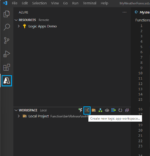Microsoft is preparing to provide Hadoop, a Java software framework for data-intensive distributed applications, for Windows Azure customers.
Hadoop offers a massive data store upon which developers can run map/reduce jobs. It also manages clusters and distributed file systems. Microsoft will provide Hadoop within a “few months,” said a Microsoft executive who wished to remain anonymous.
The technology makes it possible for applications to analyze petabytes of both structured and unstructured data. Data is stored in clusters, and applications work on it programmatically.
“They are probably seeing Hadoop adoption trending up, and possibly have some large customers demanding it,” said Forrester principal analyst Jeffrey Hammond.
“Microsoft is all about money first; PHP support with IIS and the Web PI initiative were all about numbers and creating platform demand. If Hadoop support helps creates platform demand for Azure, why not support it? Easiest way to lead a parade is to find one and get in front of it.”
Microsoft’s map/reduce solution, codenamed “Dryad,” is still a reference architecture and not a production technology.
Further, AppFabric, a Windows Azure platform for developing composite applications, currently lacks support for data grids. Microsoft has experienced difficulty in porting Velocity, a distributed in-memory application cache platform, to Windows Azure, because Velocity requires administrative privileges to install, the anonymous executive told SD Times.
“Do they feel so ‘way behind’ that they are rolling out a Java-based product without a .NET-based ‘superior’ alternative ready to go?” asked Larry O’Brien, a private consultant and author of the “Windows & .NET Watch” column for SD Times. “Perhaps they feel that distributed map/reduce is not really all that important, that they can put Hadoop on the ‘check-off box’ and it won’t be embarrassing that it gives Java developers a capability that .NET developers don’t have?”
The Azure platform is not restricted to .NET development. Microsoft partnered with Soyatec to produce the Azure SDK for Java. However, using Hadoop as a data grid solution is a departure from Microsoft’s approach to data access.
.NET’s existing data access APIs, such as the ADO.NET Entity Framework, provide an object-relational mapping (ORM) framework that abstracts data from the application.
Microsoft’s Velocity caching technology resides in the business logic layer, in the sense that it is in-memory and object oriented, said William Bain, CEO of ScaleOut Software. Dryad emphasizes its parallel computation model, which can be integrated with file storage, he added.
Hadoop integrates parallel data analysis with the data storage layer rather than solely residing in the business logic layer. Its use of its own distributed file system with data accessed from the file system “creates its storage integration and the associated complexity,” Bain claimed
“Map/reduce is definitely lower-level than SQL,” said O’Brien. “However, because it’s more like a powerful mathematical technique than a black box whose internal workings are unclear, it’s not necessarily ‘more complex’ to think through a tough data analysis problem in terms of map/reduce. Map: ‘Farm out all of this identical work to a whole bunch of different computers.’ Reduce: ‘Gather those results and combine duplicates.’ Feed the reduced dataset into another map/reduction process. Conceptually, that’s pretty easy to reason with!”
Microsoft can gain a data grid capability in Azure by acquiring a partner such as ScaleOut Software or Alachisoft, said Forrester senior analyst Mike Gualtieri. Microsoft is not far behind other platform players in providing distributed data grids on the cloud, he added.
ScaleOut Software uses a memory-based approach to map/reduce analysis. Its parallel method invocation integrates parallel query with map/reduce on object collections stored in the grid.
“In-memory, object-oriented map/reduce within the business logic layer offers important advantages in reducing development time and maximizing performance,” said Bain. “Over time, we are confident that this approach will efficiently handle petabyte data sets, which currently rely on file-based implementations.”
Additionally, there are open-source map/reduce solutions for .NET. A project called hadoopdotnet ports Hadoop to the .NET platform. It is available under the Apache 2.0 open-source license. MySpace Qizmt, a map/reduce framework built using .NET, is another alternative. It is licensed under GNU General Public License v3.





